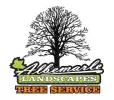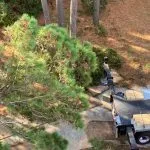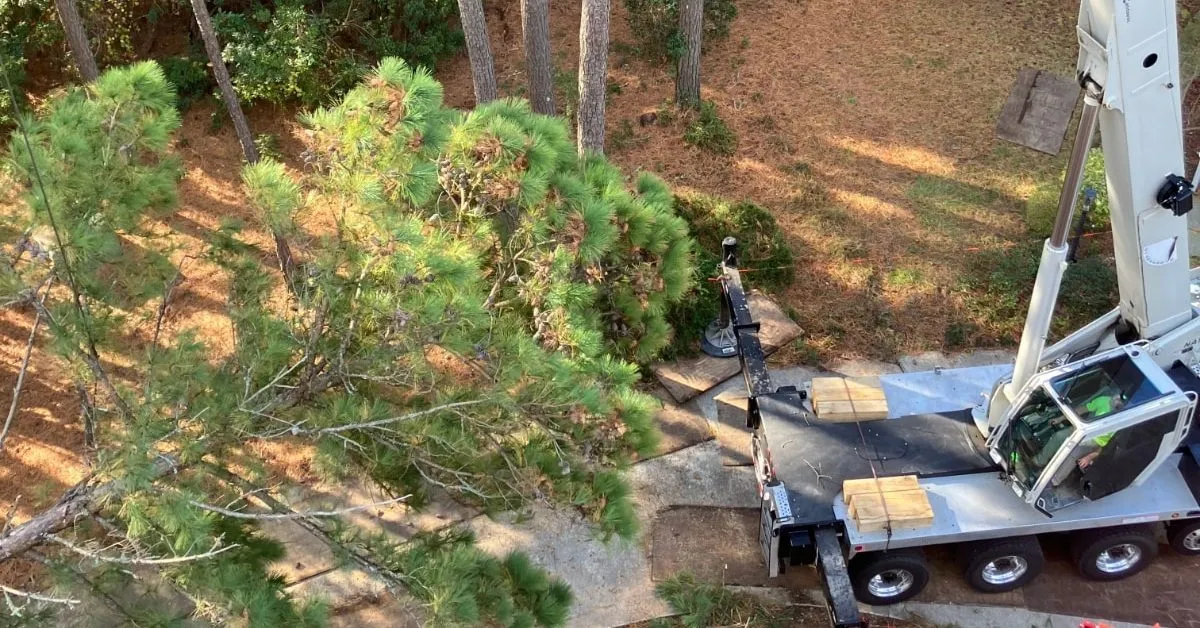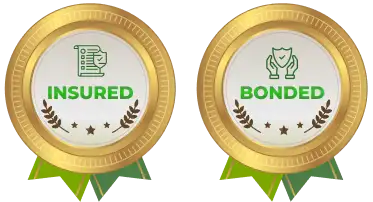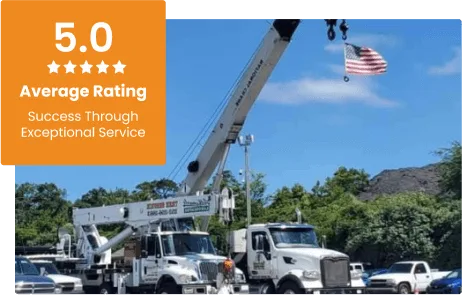A Homeowner's Guide to Tree Removal
August 22, 2025
Trees are among the most valuable assets on your property, providing shade, beauty, and environmental benefits that can last for generations. However, there are times when tree removal becomes necessary for safety, health, or practical reasons. As experienced arborists serving the Albemarle area, we understand that deciding when to cut down a tree can be challenging for homeowners. This comprehensive guide will help you recognize the warning signs and make informed decisions about tree removal.
Safety Hazards: When Immediate Action is Required
The most critical reason for tree removal is safety. Certain conditions pose immediate risks to people and property, requiring prompt professional intervention.
Structural Damage and Instability
Trees with significant structural damage cannot be safely preserved. Look for large cracks in the trunk, major limbs that have split but haven’t fallen, or trees that are leaning at dangerous angles. Storm damage often creates these conditions, and what appears to be minor damage on the surface may indicate serious structural compromise beneath.
Root System Problems
A tree’s root system is its foundation, and when roots are severely damaged or compromised, the entire tree becomes unstable. Construction damage, soil erosion, or root rot can undermine a tree’s stability. Signs include exposed roots, soil heaving around the base, or the tree beginning to lean after previously standing straight.
Proximity to Power Lines and Structures
Trees growing too close to power lines pose serious safety risks and may require removal or significant pruning. Similarly, trees that threaten buildings, driveways, or other structures may need to be removed, especially if they cannot be safely maintained through pruning alone.
Disease and Pest Infestations
Trees suffering from severe disease or pest infestations may need removal to prevent spread to other healthy trees and to eliminate safety risks.
Fungal Diseases
Certain fungal infections can be fatal to trees and may spread to other trees in your landscape. Root rot, Dutch elm disease, and oak wilt are examples of conditions that often require tree removal. Professional arborists can identify these diseases and recommend appropriate action.
Insect Infestations
Severe insect infestations, such as emerald ash borer or bark beetles, can kill trees and make them structurally unsound. Dead or dying trees from pest damage become brittle and unpredictable, making removal the safest option.
Signs of Decline
Trees showing signs of severe decline, such as extensive dead branches, sparse foliage, or fungal growth on the trunk, may be beyond saving. Early intervention can sometimes help, but advanced cases often require removal.
Dead or Dying Trees
Dead trees, often called “widow makers” by arborists, are among the most dangerous trees on any property. They become unpredictable and can fall without warning, especially during storms or high winds.
Identifying Dead Trees
Dead trees may not always be obvious, especially during dormant seasons. Look for brittle branches that break easily, bark that’s falling off in large sections, and the absence of new growth during growing seasons. Fungi growing on the trunk or major branches often indicate internal decay.
Partially Dead Trees
Trees that are partially dead may also require removal, depending on the extent of the damage and the tree’s species. Large dead sections create imbalanced weight distribution, making the tree unstable.
Construction and Development Needs
Sometimes healthy trees must be removed for construction or development projects. While this should always be a last resort, certain situations make removal necessary.
Foundation and Infrastructure Protection
Trees planted too close to foundations, septic systems, or underground utilities may need removal to prevent damage. Large trees with extensive root systems can cause foundation settling, crack driveways, or damage underground pipes.
Space Requirements
Major renovations or additions may require tree removal to create adequate space. In these cases, consider whether the tree can be relocated or if strategic pruning might solve the space issue.
When Tree Removal May NOT Be Necessary
Before deciding on removal, consider alternatives that might solve your concerns while preserving the tree.
Professional Pruning
Many problems can be addressed through professional pruning. Dead branches, crossing limbs, and even some structural issues can be corrected by skilled arborists. Proper pruning can extend a tree’s life and improve its safety.
Treatment Options
Some diseases and pest problems can be treated successfully, especially when caught early. Soil treatments, trunk injections, and other therapeutic measures may save a tree that initially appears to need removal.
Cabling and Bracing
Trees with structural weaknesses may benefit from cabling or bracing systems that provide additional support. These techniques can extend the life of trees with minor structural issues.
The Importance of Professional Assessment
Determining whether a tree needs removal requires expertise that most homeowners don’t possess. Professional arborists have the training to identify subtle signs of disease, structural problems, and safety risks that aren’t apparent to untrained eyes.
Certified Arborists
Always consult with certified arborists who can provide objective assessments. They can evaluate the tree’s health, identify potential problems, and recommend the best course of action. Sometimes what appears to be a dying tree can be saved with proper treatment.
Multiple Opinions
For valuable or significant trees, consider getting multiple professional opinions. Different arborists may have varying perspectives on treatment options and the urgency of removal.
Timing Considerations for Tree Removal
When removal is necessary, timing can be important for both practical and regulatory reasons.
Seasonal Considerations
While emergency removals may be necessary at any time, planned removals are often best scheduled during dormant seasons. This timing minimizes stress on surrounding plants and may be more cost-effective.
Local Regulations
Many communities have regulations governing tree removal, especially for larger trees or those in protected areas. Check local ordinances and obtain necessary permits before proceeding with removal.
Weather Considerations
Avoid scheduling tree removal during severe weather conditions or immediately after storms when conditions may be dangerous for tree service professionals.
FAQs
How do I know if a tree needs to be removed?
Look for signs such as severe leaning, dead branches, fungal growth, root damage, or large cracks in the trunk. A certified arborist can provide a professional evaluation.
Is it okay to remove a tree myself?
Tree removal can be dangerous. For small trees away from structures, it may be safe to DIY. However, large or compromised trees near buildings or power lines should always be handled by professionals.
What is the best time of year for tree removal?
Late winter or early spring is ideal when trees are dormant and easier to manage. However, hazardous trees should be removed immediately regardless of the season.
Will I need a permit to cut down a tree?
Some municipalities require permits for tree removal, especially for large or protected trees. Always check local regulations before proceeding.
What happens to the stump after tree removal?
Stumps can be ground down or completely removed. Stump grinding is the more common and cost-effective option, reducing the stump below ground level.
Can a sick tree be saved instead of removed?
In many cases, yes. Early treatment of diseases or pests, structural support systems, or targeted pruning can preserve a tree. An arborist can determine if saving the tree is possible.
How much does professional tree removal cost?
Costs vary based on tree size, location, complexity, and services needed. Getting multiple quotes from certified arborists is recommended.
What should I do after a tree is removed?
Consider replacing the tree with a new planting if space allows. Also, use the opportunity to re-evaluate your landscape design and soil health.
Conclusion
Deciding when to cut down a tree requires careful consideration of safety, health, and practical factors. While preserving trees should always be the first choice, there are situations where removal becomes necessary for safety or other compelling reasons. The key is working with qualified professionals who can assess your specific situation and provide expert guidance.
At Albemarle Landscape and Tree Service, we understand the importance of trees to your property and community. Our certified arborists are committed to helping you make informed decisions about tree care and removal. We provide comprehensive evaluations, explore all treatment options, and when removal is necessary, we ensure the work is done safely and professionally.
If you’re concerned about a tree on your property, don’t wait until it becomes a safety hazard. Contact us (252) 256-9128 today for a professional assessment and personalized recommendations for your landscape.
